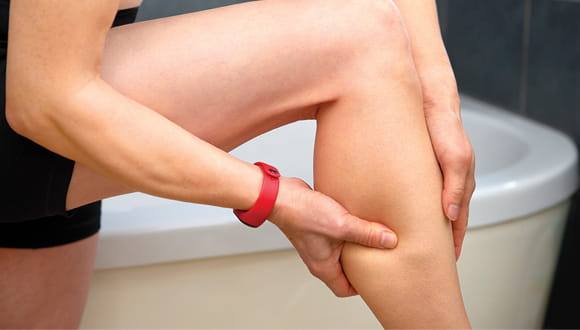Does Pickle Juice Help With Muscle Cramps?
Nov. 29, 2022 - Katie McCallumGetting a leg cramp while exercising isn't just painful. It also disrupts your workout.
Could pickle juice be the answer?
"There are a lot of anecdotal reports of pickle juice helping with exercise-induced muscle cramps," says Dr. David Braunreiter, a sports medicine specialist at Houston Methodist. "In reality, any perceived benefit of pickle juice for cramps is likely due to the power of suggestion more than anything else."
What, then, is someone to do when a muscle cramp hits? And are there ways to prevent them from happening in the first place?
"A localized muscle cramp is essentially a reflexive spasm or contraction of a muscle, where it fires and shortens but doesn't release," explains Dr. Braunreiter. "This happens due to a heightened sense of neurofeedback from the brain that causes an exaggerated pain signal."
What triggers this? It might be more complicated than you think ...
(Related: Why Do We Get Muscle Cramps at Night?)
What causes muscle cramps during exercise?
"Many theories have been thrown around over time as far as what actually causes a cramp — dehydration, a lack of sodium, potassium or calcium," says Dr. Braunreiter. "None have really been solidified as an actual reason."
These theories do, however, explain the origin of the pickle juice idea. It's packed with both sodium and potassium.
"Even with hydration, we just don't see this hold up in practice," says Dr. Braunreiter. "You can be very, very hydrated and still develop a leg cramp. You can also be dehydrated and not develop one."
Rather, Dr. Braunreiter says the most important contributor to the development of muscle cramps while working out is likely a lack of appropriate conditioning for the environment, typically the lingering summer heat.
"We see this most often during early high school football and soccer seasons," says Dr. Braunreiter. "You don't really see cramping halfway through the season, when temperatures are cooler."
Dr. Braunreiter, who notes that improper nutrition also may play a role, adds that unseasonably warm weather likely contributes to late-season cramps.
"We can extrapolate this trend to other activities, too," Dr. Braunreiter says.
For instance, if you usually run on a treadmill indoors but one hot summer day decide to do your 5-mile run outside, your body isn't conditioned for that environment and could be at risk for cramping.
"This is especially true if it's also humid, since this reduces your body's ability to dissipate internal body heat," says Dr. Braunreiter. "Sweat can't evaporate off the body as easily in a humid environment, and sweat evaporation is how the body cools itself down."
What's the best way to get leg cramp relief?
When a cramp hits, Dr. Braunreiter recommends stretching the affected muscle.
"The goal is to break the reflexive contraction that's happening," explains Dr. Braunreiter. "While the reason isn't fully understood, stretching helps with that. There can be some discomfort, but there's no harm in stretching a cramped muscle."
There's also no risk in continuing with your exercise.
"Once you break the cramp and it settles down, it's perfectly fine to continue your run or whatever type of workout you're doing," says Dr. Braunreiter. "Cramped muscles do tend to re-cramp, so you may be interrupted again — but there's no physical harm in resuming the activity."
How to prevent leg cramps when exercising
As Dr. Braunreiter puts it, pickle juice isn't going to save you from cramping during your workout. You're also not more likely to cramp if you forgot to drink it beforehand.
"The most important factor in preventing exercise-induced cramps is steadily acclimating yourself to the environment you're working out in — appropriately training to deal with the heat or humidity," recommends Dr. Braunreiter.
A good stretching routine is also potentially beneficial. Using a foam roller or massage gun on hot spots prior to and after exercise may help, too, Dr. Braunreiter adds.
"This may be less about stretching out the tissue and more about pre-treating tight, hot spot areas where you have a lot of nerves firing," explains Dr. Braunreiter. "You're essentially trying to desensitize the nerves so they're less likely to trigger a spasm in the muscle."
Still, Dr. Braunreiter says none of this is a guarantee. Because the mechanism behind muscle cramps isn't well understood, it's difficult to offer fool-proof solutions, he notes.
"We can make sure you're adjusting to the environment in which you're going to be doing the bulk of your exercise," Dr. Braunreiter says. "We can make sure you're hydrated and adequately nourished. But as far as preventing cramps, it's hard to give a better answer beyond that. These are likely the best methods of prevention. And preventing leg cramps from happening in the first place is also the best method of treatment, too."
Are muscle cramps after a workout concerning?
Getting a localized muscle cramp when exercising isn't a big problem or concerning. But developing a cramp afterward or getting full-body cramps during a workout might be an indicator of trouble.
"If you're getting muscle cramping after the fact, especially if they're felt all over, that would be pretty unusual and should be a red flag to see a medical professional," recommends Dr. Braunreiter. "There's also a subset of cramps called heat-induced muscle cramps that can be a sign of impending heat exhaustion."
Heat-induced muscle cramps tend to be more diffuse, from shoulders to hips to feet — rather than localized, such as to your calf.
It's important to take this type of cramping seriously since heat exhaustion can lead to heat stroke, a medical emergency that requires immediate attention. If you're exercising in a hot environment and feel full-body cramps, seek shade and cooler temperatures as soon as possible.


